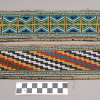belt
belt
belt


Beaded belt or sash for bandolier bag
Peabody Museum's database.
Read More About This Relative
Glass beads Fabric, Yarn, and Thread.
A loom made the beaded belt. Weaved fabric hold together the woollen tassels.
Wavy lines, crosses, hourglass shapes, continuous straight line.
The wavy lines represent water or mountains for Indigenous people. The crosses represent the four elements or the four directions. The hourglass is a representation of people. Or teepees for family. The continuous straight line is the path of life. (Interpreted Sheila Wheesk)
Used as a belt or sash. Displayed at the Peabody Museum of Archaeology and Ethnology, as culture material. (38-44-10/12735)
Peabody Museum's database.
Provenance
Chief-of-the-Five-Tribes Coatash first owned the beaded belt, then William C. Johnson owned it. Johnson donated the belt in 1927 to the President and Fellows of Harvard College, Peabody Museum of Archaeology and Ethnology.
Peabody Museum's database.
Peabody Museum of Archaeology and Ethnology classify the object as: Beaded belt or sash for bandolier bag.
About This GRASAC Record













Peabody Museum's database.
 Knowledge Sharing Platform
Knowledge Sharing Platform

